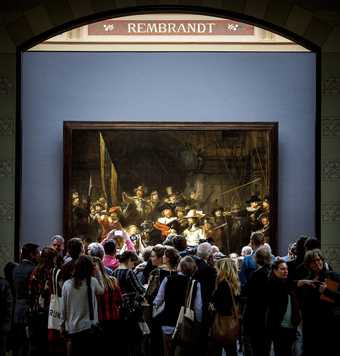‘I know of nothing more ridiculous than all those people who crowd about The Night Watch and sigh with ecstasy … the grandiose … grows tiresome after a while. There are mountains like that; when you stand before them you shout, “Nom de Dieu …” But for every day a simple little hill does well enough. Listen, Monsieur Vollard, if The Raft of the Medusa hung in my bedroom, it would make me sick.’*
— Paul Cézanne
You couldn’t disagree with Cézanne: it would be rather tiresome to wake up to Théodore Géricault’s The Raft of the Medusa 1818–19 every morning. But then it’s a curious way to criticise a grand and admittedly oversize painting. I happen to like The Raft of the Medusa a great deal. I’m glad to see it in the Louvre when I go to Paris, but also glad I don’t have to see it every day. And if someone tells me that they don’t like it, I’m interested to hear why.
We don’t have to like masterpieces. It’s an important right to reserve. It keeps us thinking and judging for ourselves, rather than accepting the judgments of others, particularly of museums, the place where the modern idea of the masterpiece was born. For me, for example, the Mona Lisa c.1503–19, the masterpiece of the Louvre and the most celebrated painting anywhere, is very boring. It is a frowsy, wooden, second-rate work by Leonardo, far inferior to his Lady with an Ermine from about 1489–90, or both versions of The Virgin of the Rocks, or many of his drawings. The myth of the mysterious smile is banal. The mystery of the sitter’s identity is a curiosity that has nothing to do with the quality of the painting itself. I would far rather spend time in the Louvre with van Eyck’s The Virgin and Child with Chancellor Rolin c.1433–4, or Watteau’s Pilgrimage to the Isle of Cythera 1717, neither of which are blocked by a camera-wielding crowd, and both of which are far greater paintings – masterpieces, if you like.

Visitors crowding around Rembrandt's The Night Watch at the Rijksmuseum in Amsterdam
Koen van Weel/AFP/Getty Images
It isn’t always easy to see a masterpiece. It shouldn’t be: great paintings are demanding things. You might find yourself looking at some celebrated canvas and simply not be in the frame of mind to connect. This happens to be my experience of Rembrandt’s The Night Watch 1642. Both times I stood in front of it I felt inadequate, was unable to tune in. It was like meeting a person you greatly admire, a celebrity perhaps, and not being able to think of a single thing to say. The only thing for it was to turn my back and vow to return in a better mood.
Not liking masterpieces is also a way of recognising that tastes change. Raphael’s Sistine Madonna c.1512–13 was held as one of the greatest masterpieces of all time. It has not been forgotten, but nowadays hardly raises the same kind of pulse. Although I might hope that Giotto’s Scrovegni Chapel frescoes, Vermeer’s The Art of Painting 1666–8 and Manet’s Olympia 1863 will always be revered, I cannot be entirely sure. We don’t have to like masterpieces. But we do have actually to see paintings to have an opinion worth repeating. Nowadays it would be strange to hear someone rail against Rembrandt and Géricault as Cézanne did – you’re far more likely to hear attacks on ‘Turner Prize art’, almost without exception by people who have not seen the Turner Prize show. And this was, it might be added, true also of Cézanne himself. He can never have seen The Night Watch. It has never left Holland, and Cézanne never left France.
John-Paul Stonard is a writer and art historian. He is currently writing a book telling the story of art, from Palaeolithic to the present day, for Bloomsbury.
